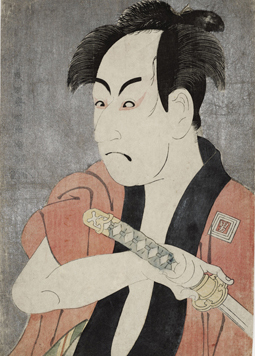 |
|
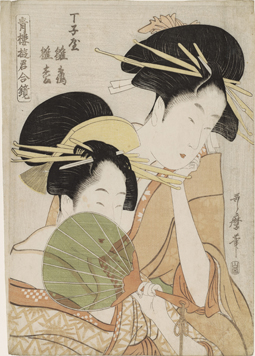 |
| Toshusai Sharaku (active 1794-95), "Actor Ichikawa Omezo as the Manservant Ippei" (1794, 5th month) |
|
Kitagawa Utamaro (?-1806), "Hinazuru and Hinamatsu of the Chojiya," from the series Courtesans of the Pleasure Quarters in Double Mirrors (about 1797) |
Such was the force of the Tohoku Earthquake of March 11 that it buckled the ground in parts of Tokyo, 400 kilometers from the epicenter. Though buildings did not collapse in the capital, many museums and galleries closed temporarily while they checked the safety of their structures and collections.
Located on a hill in the upscale Tokyo neighborhood of Hiroo, the Yamatane Museum of Art is fortunate in that it moved into sturdy new quarters only a year and a half ago. Though it suffered no structural damage, the Yamatane closed for a week after the big quake, but this was primarily due to the vagaries of power outages and train stoppages, as well as concern about the ongoing aftershocks. The museum is now open again for only slightly shorter than usual hours to conserve electricity. This means it is possible to catch the marvelous collection of late 18th-century ukiyo-e prints and paintings on display there until April 17.
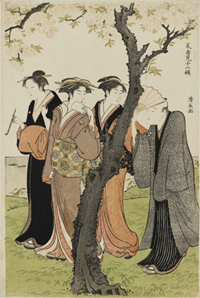 |
| Torii Kiyonaga (1752-1815), "The Third Month," from the series Twelve Months in the South (about 1784) |
These are works that were created in Shogun-era Edo, acquired in Japan or Europe by American connoisseurs of Japanese art a century later, and eventually donated to the Museum of Fine Arts, Boston, with which several major collectors had close ties. Now, after the elapse of another century, they are beginning to find their way back to Japan, albeit temporarily, through a series of exhibitions including the current one at the Yamatane.
The Boston MFA boasts what is probably the largest collection of ukiyo-e to be found anywhere outside Japan: around 54,000 woodcuts, 700 paintings, and thousands of
hanpon (woodblock-printed books). The majority of these works -- over 30,000 prints and all the paintings -- were amassed by Bostonian Japanophile William Sturgis Bigelow (1850-1926), first when he was living in Paris and later in Japan. Many of these works lay uncataloged in the MFA's vaults until recently, when an ambitious digitizing and databasing project made the entire collection accessible for the first time to experts in Japan as well as America.
One serendipitous consequence of all those years in storage is that the prints are in remarkably good condition. To keep them that way, in fact, the MFA only displays them for short periods. The 140-odd works on the walls of the Yamatane this month will not be exhibited again for at least five years.
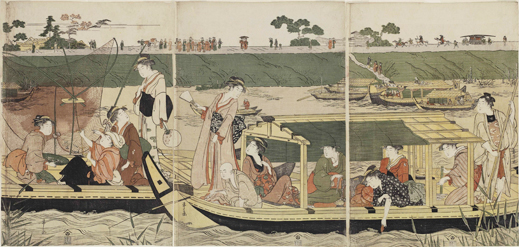 |
Chobunsai Eishi (1756-1829), "Fishing and Boating on the Sumida River" (about 1790-92)
|
The Yamatane show focuses on three masters of a particular epoch: Torii Kiyonaga, Kitagawa Utamaro, and Toshusai Sharaku of the Tenmei and Kansei eras (1781-1801), when the colored woodcuts known as nishiki-e were at their zenith. Indeed, the fame of a few later artists like Hokusai and Hiroshige notwithstanding, this is commonly considered the golden age of ukiyo-e, and each of the three artists highlighted here has his champions who claim him as the greatest of all. Utamaro is revered for his playful and delicately erotic portraits of beautiful women, particularly those working in the pleasure quarters of Yoshiwara. Sharaku is legendary for the way he emerged out of nowhere, produced a flurry of kabuki actor portraits in a radically new, convention-flouting style, and vanished just as abruptly ten months later. (One theory is that actors found his caricatures so unflattering that they hounded him out of business.) Kiyonaga, though less flamboyant than the other two and perhaps for that reason not as well known to average ukiyo-e fans like your ignorant reviewer, is, I learned, touted by many aficionados as representing the pinnacle of ukiyo-e art, both in his technique and his composition.
Even for visitors who have seen plenty of ukiyo-e shows, this one is full of happy surprises. Utamaro's section reveals a breadth of thematic material beyond his celebrated courtesan portraits, including scenes of women engaged in everyday chores like cleaning or kitchen work, as well as some hilarious parody pieces of the Seven Gods of Good Fortune frolicking with young ladies of dubious repute. Large triptychs of riverside party scenes by contemporaries of the Big Three like Utagawa Toyokuni and Chobunsai Eishi offer a rare chance to see ukiyo-e techniques applied to a broader than usual canvas, and also foreshadow the landscapes of Hiroshige and Hokusai. And the 21 prints by Sharaku (out of only 140 or so in existence!) testify to the vibrant and iconoclastic genius of this artist throughout his all-too-brief career. (See this month's "Picks" for a preview of the Sharaku exhibition at the Tokyo National Museum from May 1 to June 12.)
Founded in 1966 to house the personal collection of Taneji Yamazaki (1893-1983), the founder of Yamatane Securities, the museum's primary focus has been on Yamazaki's greatest love -- Nihonga, the "Japanese-style painting" genre that utilizes traditional pigments and brush techniques, but is actually relatively modern (the term Nihonga was first coined in response to the influx of Western art influences in the late 19th century). The Yamatane's collection of modern and contemporary Nihonga is worth a visit in its own right. A good place to start would be the exhibition that follows the Boston ukiyo-e show: A Profusion of Flowers: Painting the Four Seasons, from April 27 to June 5, will showcase Nihonga from the late Edo period up to the present.
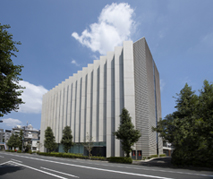 |
|
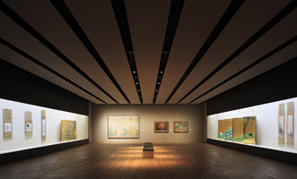 |
| The Yamatane Museum of Art in Hiroo, Tokyo. The museum occupies the ground floor and basement of the building, which was completed in 2009. Photo © Norio Koike 2009 |
|
Interior view of a gallery in the Yamatane Museum, showing one of its Nihonga exhibitions. Photo © Norio Koike 2009
All artwork is from the William Sturgis Bigelow Collection; photographs © 2011 Museum of Fine Arts, Boston. All rights reserved. |